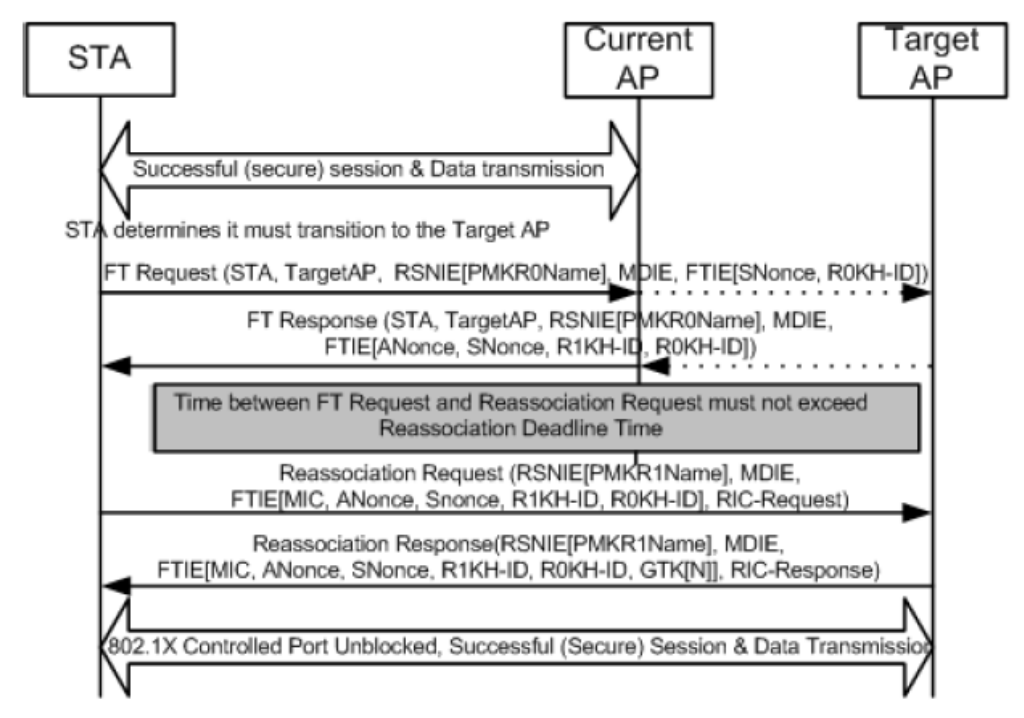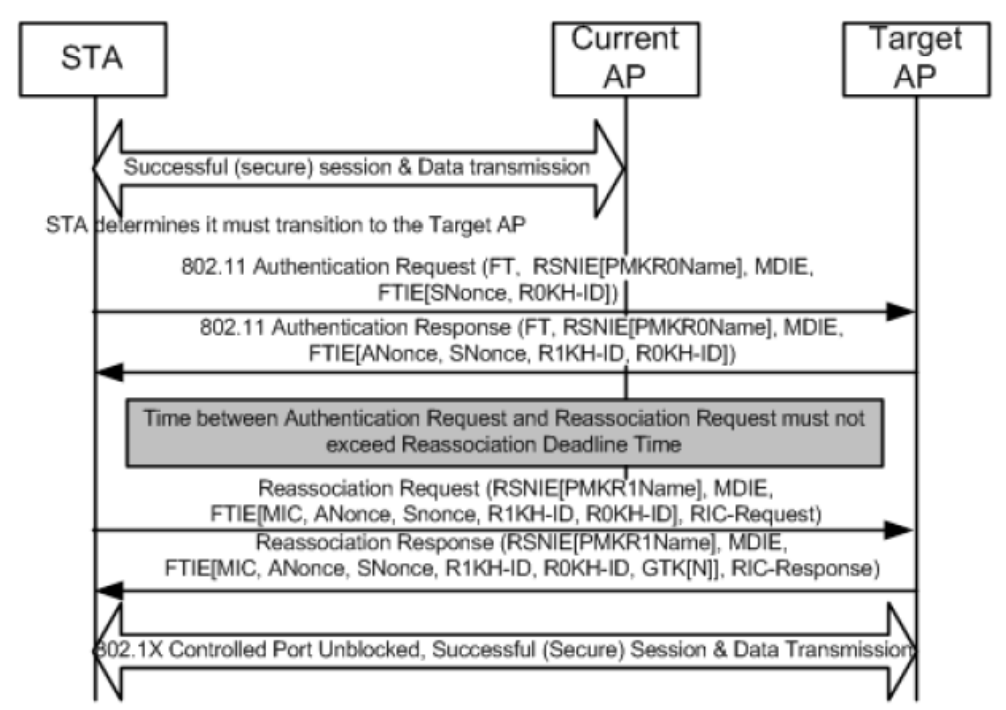Normally, Wi-Fi connections does not need any explicit set up for roaming. When a station moved away from the access point, it will notice about that and find another AP and reconnect. The 802.11r (fast basic service set transition), however, is to help make this transition faster. Hence it is called the fast transition (FT) extension.
Mechanism of 802.11r
In a 802.11 network, we have access points (APs) that announces the SSID and its BSSID. The SSID is the name of the network. The BSSID is the MAC address of the AP. The address is announced so the station can address the frame to the AP. If there are multiple APs sharing the same SSID, we call it the ESS. Conceptually, the ESS is the set of all BSSID of teh same SSID.
The 802.11r introduced some other parameters in addition to these identifiers: First we have the mobility domain assigned to APs, which declares the subset of ESS that allows station to roam around. A station knows it can transit from one AP to another if they share the same mobility domain. While station-AP association in Wi-Fi is done using four-way handshake, the FT depends on the pairwise transit key (PTK) for this. The PTK, in turn, is derived from the pairwise master keys (PMKs). There are PMK-R0 which is supposed to be derived from the master session key (MSK) and stored in the wireless LAN controller, and there are PMK-R1 which is supposed to be derived from PMK-R0 and stored in all APs. It is the PMK-R1 that creates the PTK. The MSK comes from 802.11x/EAP, which if you’re not using the RADIUS server for Wi-Fi authentication, you probably hard-coded the R0 and R1 key instead of deriving them.
Hence, in the wireless LAN, we have the controller as the PMK-R0 key holder (R0KH). The APs as the PMK-R1 key holder (R1KH). And the station are the PMK-S0 key holder and PMK-S1 key holder (S0KH and S1KH, S for supplicant). Supplicants are to receive the PMK-R0 and derives PMK-R1, or receives the PMK-R1 and derives the PTK. Each key holder is identified by an ID, e.g., R0KH-ID.
Here is how the transition actually works in 802.11r, pictures from https://www.cwnp.com/uploads/802-11_rsn_ft.pdf
First is FT over the distribution system (DS). This is when the APs are connected in wire so they can talk to each other out-of-band. It operates as follows:

Fast transition is a Wi-Fi extension that needs both the AP and the station to support it. It is the station to determine if transition is needed, where to transit, and to initiate the transition.
If it is FT over-the-DS, the FT request is sent to the current AP with all required information elements (IEs), including the mobility domain, R0 name, and the R0KH-ID. Then this request is relayed to the target AP by the current AP, and the response, also relayed by the current AP, will arrive the station. Then the station can start the reassociation request directly to the target AP, which will include the R1 name and R1KH-ID. Network connection is transited to the new AP after the reassociation request completed.
The other way is FT over the air. This does not require the APs can talk to each other.

In this protocol, once the station decided that transition is needed, it initiate the authentication with the target AP, which includes the FT option with the mobility domain, the R0 name, and the R0KH-ID. The authentication response will carry the similar information elements to confirm about the FT. Then the station can start the reassociation request after it authenticated with the new target AP. This part is same as the case of over-the-DS.
802.11r with OpenWRT
OpenWRT has built-in 802.11r support, given that the device supports it. To set it up, we simply need to:
- check the checkbox on the LuCI to turn on 802.11r FT
- set up the mobility domain (a 4-hex-digit same for all APs of the same ESS)
- set up the NAS ID (a string to uniquely identify this AP, usually recommended to use the AP’s MAC address)
- check the checkbox for “Generate PMK locally”
This is in case of PSK used. In case of using an authentication server such as RADIUS, the set up would be more complicated. Most important is to set up the R0KH list and R1KH list. In OpenWRT, the R0KH list is assumed to be multiple lines of:
<MAC address>,<NAS ID>,<128-bit key>
which the MAC address and NAS ID is supposed to be of the controller. The R1KH list, however, is multiple lines of:
<MAC address>,<R1KH-ID>,<128-bit key>
which the MAC address and the R1KH-ID is supposed to be of the APs. The R1KH-ID should be same as MAC address in format of 6-octets with colons. The 128-bit keys in both cases should be all identical but can be generated randomly (e.g., MD5 of /dev/random).
OpenWRT defaults to use over-the-DS. I found this to be problematic in some devices (most notably iOS devices) but the root cause is not known. However, over-the-air can work well.
Another OpenWRT default is the “reassociation deadline”. This is the time limit between the FT request and the reassociation request. It is set to 1000 (i.e., 1.024 seconds) but seems too short for some devices. This will fail the FT if the reassociation request cannot be made on time.
Therefore, it seems it is more robust if we set OpenWRT to use over-the-air (on all APs), and set the reassociation deadline to larger (e.g, 10000 for 10.24 seconds). The longer deadline just raise the upperbound and it should not hurt the performance.
One consequence of doing over-the-air FT is that the original AP may not know the station disassociated with it. It will be a problem if the station FT to a new AP and then FT back, because the original AP would not expect any need to update the key. To mitigate this, we should tune down the station inactivity limit, which specifies the number of seconds the AP should heartbeat the station and disassociate it if not found.